In this article I’m going to discuss my views on art markets. I’ve attended several over the past two years. Some good, some not so good (a.k.a pretty terrible). I’m going to share my experiences with you and fill you in on some of the top tips I’ve learnt along the way!
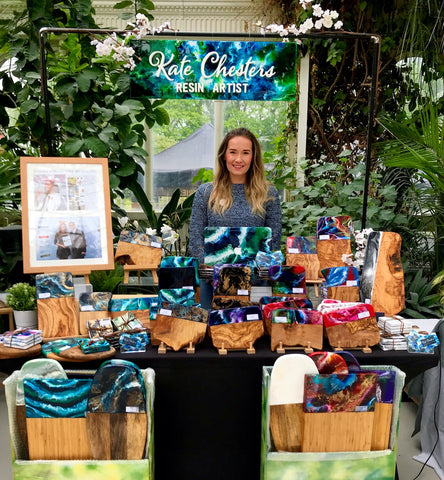
Where it all began...
In Winter 2014 I graduated from Liverpool Hope University with a Masters Degree in Art History and Curating. The previous year I had graduated with a Bachelors Degree in Fine Art. I achieved good grades too - I was one mark off a First each time. How. Bloody. Annoying.
Anyway. I had learnt about semiotics, chiaroscuro, diptychs and frescos. I was taught about the Medici family, the Old Masters, and the Pre-Raphaelite Brotherhood. I had developed an extensive knowledge of art history.
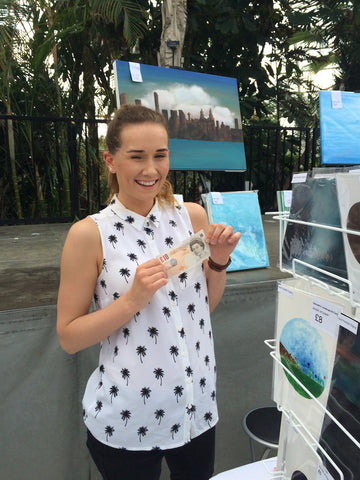
My first ever sale at an art market. My Mum took this picture.
But… I didn’t know the first thing about business.
Like with most courses in university, they don’t actually teach you how to make money and make a living from your area of study once you graduate. I’ve been properly trying to make a living from my art for around two years now, and I’m still learning each day.
There are several options when it comes to selling your handmade artisan pieces. You can sell online and create your own website, or you can sell via a high traffic website (Amazon, Etsy, Ebay, Folksy etc.). You can try to build up a following online, through social media channels, to create a greater awareness of your work. Or you can sell in person, either through your own brick and mortar store or a shop that will stock your goods. Or you can sell your work at art markets, which are either one-off pop ups, or regular daily/weekly/monthly events.
It completely depends on your business which avenue you go down. Personally, I have my own website and Etsy shop, and more recently I have set up an Amazon store. I regularly post on Facebook and Instagram, and I try to attend as many good art markets as I can. I’m currently averaging one event every 6 weeks, but I’d like for that to be more frequent.
So, the first art market that I ever did was two years ago in May 2016 and I didn’t sell a single thing.
I don’t think I sold anything at my second event either. I remember - naively - worrying that I would sell out of everything and that I wouldn’t have enough work to show at my next event. A wonderfully foolish thought.
However, it wasn’t my work that was the problem. It was the event. I won’t reveal any names, companies or venues in this post - frankly, I could end up shooting myself in the foot! And even though some events have been woeful at best, they’re still nice days out. Stall holders are some of the friendliest people you’ll ever meet.
That first event though.
If you’re a fellow artisan maker reading this post, you’ll have probably had a similar experience yourself. There were several issues with this fair - the first being that the targeted clientele wasn’t right for the event. And the footfall was sparse at best.
It’s an organisers duty to market the event to enough people who will want to actually buy from stallholders. A hell of a lot of time, money and effort goes into preparing for a handmade event. And if the organisers can’t get a good footfall through the door, it’s all a bit of a waste.
I’m extremely picky now when it comes to which events I will attend. Stall fees can range from £30 up to thousands of pounds, so it can be an extremely risky game.
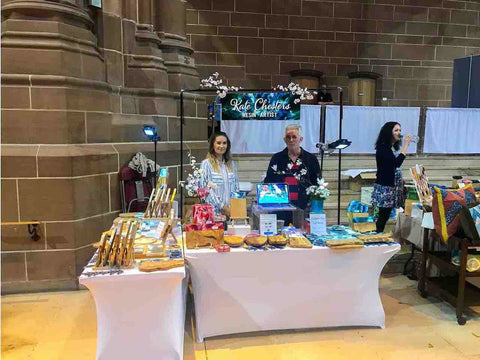
Another Lousy Event
In 2017 I took part in an art fair which I paid several hundred pounds to be at. Most stall holders paid well over a thousand. Eye-watering to say the least. Very few people sold a single thing. Luckily I was one of the few to make a profit. So what went wrong at this event?
The organisers misled the artists to believe that thousands of serious buyers would attend. Their advertising efforts were poor and ineffective. There was no targeted social media marketing to reach new and potential customers. There were no posters in the local area notifying residents of the event.
At best, a few hundred people visited the event over the three day period. Definitely underwhelming.
The organisers also seriously annoyed the artists. Once they realised that the exhibiting artists who’d paid them in excess of £80,000 (I did the rough maths) weren’t happy with their efforts, they made themselves sparse. Nobody official was ever around to answer questions or speak with the artists.
During an event (a well managed one anyway) the organiser will usually come round each stall to introduce themselves. They’ll make sure everything is okay, and gauge how the event is going for that person. And then once an event has finished, the organiser will ask for feedback from stallholders, usually via email.
So what did I learn with this event?
I thought this event would be prestigious and that I would sell a lot of my work. Instead, I felt conned, as did the majority of the other stallholders. Ever since that event I now always reach out to previous stallholders to get their honest opinions.
I’ll search social media pages for artists who have previously attended and I’ll send them a message. I’ve been shocked at some of the responses I’ve had - some of the events that I was sure would be worth my time, I’ve been severely warned against.
And from having this social approach, I’ve made many new and wonderful connections. I’ve been recommended some brilliant events to attend, and I’ve been given invaluable advice.
That’s the main thing I’ve found at every event I’ve been part of - the stallholders are some of the loveliest people you could wish to meet. As well as this, having a friendly and approachable person in charge makes such a difference to an event.
This has been a pretty negative post so far about artisan markets. But I do like them! Honestly!
Because I’m so choosy about where to exhibit my work, I generally don’t have any bum events where I don’t make a profit now. I’m constantly looking for new art markets to attend though. One of the best ways to do this is through simply having conversations with your fellow stall holders at events. Check out their social media - have they posted pictures of events which appear bustling with customers?
As expected, the busiest and most profitable events tend to happen in the run up to Christmas. People have a reason to buy gifts, either for themselves or for loved ones. Liverpool has several beautiful venues which host popular art markets throughout the year - many of which I will be attending!
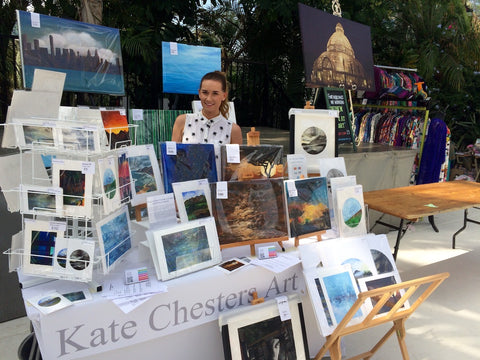
Real Life Beats Online
For me, I find that selling my pieces in person is soooooo much easier than selling on the internet. Customers can pick up my cheese boards, feel the natural groove of the wood, touch the glossy smooth resin. Although I try to take the best pictures possible of my artisan boards for my website, featuring every angle to give the best possible impression, nothing beats seeing something in person.
In 2015, for around six months, I worked in a car dealership. I know, I feel sorry for my previous self too. But one of the best sales tips I learnt there was to allow the customer to physically touch whatever it is you’re selling. “Bums on seats sell cars” my manager would say. And he was right! When a customer picks up your product they begin to imagine owning it. And we all know, when you’re holding something that you like, it’s really hard to then put it back down and walk away.
Tips For A Successful Event:
Do your research
This is key. Is this a well established event, known to the local community? What kind of advertising efforts do the organisers employ? What sort of response is it getting on social media? Will it have the footfall you are hoping/anticipating for? How many people attended the previous event?
Visit the event
If you’re unsure whether to exhibit at an event, and you can’t find relevant information through researching, then your best bet is to actually visit it yourself in person!
Will your target audience attend this event?
If you’re selling fine jewellery then a school’s summer fair with hundreds of kids probably won’t be the right event for you. Another consideration is do customers have to pay a fee to get in? This can negatively impact footfall at events if they are not well established.
Who contacted who?
I’m always wary when a new company that I haven’t heard of reach out and ask me to attend their event. Sometimes, with a bit of research, you can discover that the event will most likely be worthwhile.
However, I think a lot can be said if an art markets organiser needs to reach out for stall holders. The best events I have ever taken part in are extremely coveted. Aspiring stall holders frantically fill out the application forms as soon as they become available in the hope of being chosen. These event organisers don’t need to reach out to potential applicants because they publicise and market their events well enough. Food for thought…
Who else is trading at the event?
Is there a good mix of sellers? Are your pieces unique enough to stand out? How many people will be there? If there is over 100 traders then competition will be tough.

Logistics
Where is the event?
Will you be indoors or outside? Is the event located in a bustling part of town with many passers by? How easy is it to find it? Can you park nearby - do you have to pay for parking? How easy/hard will it be to unload and set up? Will you need a trolley to move your things?
Another pretty important aspect to consider - will everything fit into your car? At the moment I’m driving a Suzuki Swift. I love it. It’s a super cute car which actually has a surprising amount of space inside it. But I sometimes struggle to fit everything in it. When it comes to upgrading my car, I think I’ll go for a bigger model. Or maybe even a van… You know you’re a proper adult when you’re considering buying a van!
You’ll need to figure out basic things on the day - where is the nearest toilet? Who will mind your stall if you have to leave it? A friend, or a neighbour at the next stall?
Do you have everything that you will need?
Bubble wrap? There's some fantastic eco cardboard versions available these days. Bags to give to customers? Will you need to supply your own trestle table? A gazebo? Do you have a table cloth? There's stretchy ones which are great for trestle tables. Do you have enough business cards? Will you need lights to highlight your stand? (Battery operated fairy lights are always a cute way to brighten up a stall). Do you have enough stock so you won’t sell out?
Create a survival kit
I have a small box which has all of my necessary bits that I might need - scissors, spare price tags, tissues, a pen, paper, sellotape etc. You’d be amazed how many last-minute problems can be solved with this little survival kit.

Money
Pricing
Do all of your items have a price tag? There’s nothing more off-putting for a potential customer than not knowing the price. The old phrase “if you have to ask you can’t afford it” - most people (myself included) will assume that they can’t, so they just won’t ask. And this could cost you many sales. Don’t try to be weirdly mysterious - your prices should be clearly visible.
It’s up to each individual seller of course, but I personally don’t increase/decrease my product prices depending on what kind of event I am selling at. I think it gives your business a more coherent feel if your pricing is consistent. Plus, I can’t be bothered to change individual price tags with each event!
Do you have a money box with enough change in it? Don’t rely on asking other stall holders for theirs, and if it’s a weekend event most banks will be closed.
Are you likely to make a profit?
Some events charge hundreds, even thousands of pounds to exhibit at. Wedding events can be particularly risky for this factor. Very rarely do people actually buy at a wedding show. Visitors go for ideas, to make appointments and later follow up with. As an exhibitor, you generally don’t make any money at these events. So it can be extremely risky as to whether future business gained will make the event financially worthwhile.
Make informed decisions and consider the customer
Most artisan makers will have a range of products, and therefore a range of prices, available. Consider the audience that are likely to visit the art markets you’re attending. You only have a certain amount of space to display your goods. Is it likely that your top end vase will sell for £300? Depending on the event, maybe not. It might be far more beneficial to display a lower cost item which will attract greater sales.
But, at the same time, you only need one person to like that expensive vase…
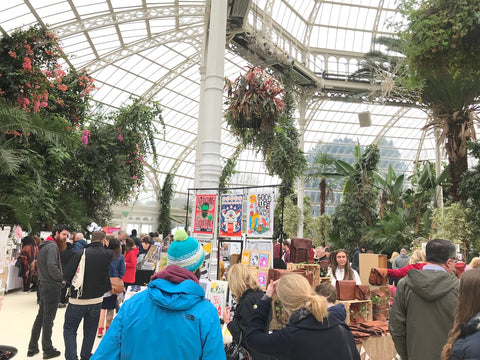
Card reader
The majority of my sales are card payments. If you’re going to take anything to an event, make sure it’s a card reader! Ones to consider: Zettle, SumUp, Square. And if maths isn’t your finest skill, maybe take a calculator too.
Price negotiation / Haggling
This is each individual sellers own preference, but I find haggling to be incredibly rude. I’ve only been asked a handful of times if I will lower my prices, and each time I’ve responded with a polite, but firm, no.
If you are an artisan maker yourself, you might completely disagree with that view. Which is your fine. But I personally don’t like it because it undermines my work. I price my work extremely fairly. When you consider the cost of buying materials, the time and skill to create each piece, and the fees that come with selling at events, it can be a pretty tight profit margin at times.
It’s your call whether to offer discounts, but if you don’t feel comfortable with it, then stick to your guns! You want a customer who loves your work just as much as you do. Customers visit art markets to find unique handmade items and to support their local community. Unfortunately, we can’t compete with the prices of mass produced items in high street stores. But your real customers understand that - that’s why they’re not buying mass produced pieces.

Public and product liability insurance
This is a must for trading at events. Most organisers require at least two million pounds public and product liability insurance. Generally this costs around £50 for the year.
The most commonly used insurance companies are CMTIA, Hiscox, Ian Wallace (Craft Insurance), AXA, Hayes Parsons, A-N, Hencilla, and NMTF.
There’s lots available - check them out and see which one is best for your business. Remember, cheapest isn’t always best. Make sure you’re fully covered.
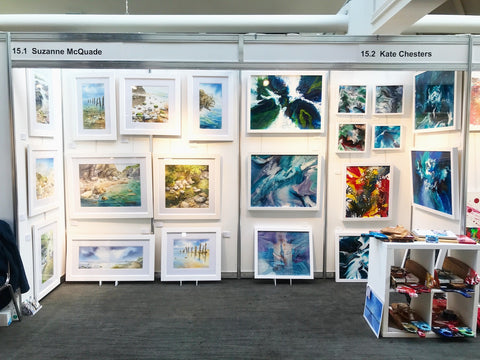
The importance of your display
This is SO important. And it takes a while to learn - I’m still very much learning! How are you going to make your stand visually appealing?
Your stall needs to be beautiful and inspiring. Customers need to immediately feel what your brand and products are all about. They need to be able to envision your unique creation being part of their life. And being able to conjure that kind of response doesn’t happen overnight.
Look at other stall holders for inspiration. What do you like about their display? My favourite stands arrange their products at varying heights and incorporate subtle accessories. A plant for example, or pretty bunting. Sticking with a certain colour theme is usually a good choice for a strong display.
Another important factor to consider - do you have a sign with your business name on it? You need an eye-catching sign that will attract customers to your stall.

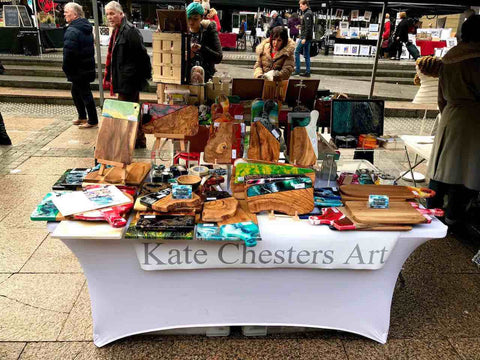
One of the main changes that I made to positively impact my stall display at art markets was to narrow down what I sell.
When I first began working as a self-employed artist, I was finding my feet for a few months. I didn’t quite know what kind of work I wanted to make. So for a short while I had a mix of original artworks, art prints, greeting cards, chopping boards, coasters, bowls etc. on display. You name it, I probably had it on my stand.
And that confuses a customer.
You’ve only got a few seconds at most to capture a customer’s attention. When someone glances at your stall, if they don’t understand exactly what you’re selling, then they’ll move on. It can be a danger to spread yourself too thin.
Now, my stand is coherent and eye-catching at events. I only display my artisan boards and coasters. It’s clear what I sell, and it’s easy for people to understand.
Think about your own stall
What do you want buyers to know about your work? Is that immediately obvious?
Are you representing your own brand? If you make jewellery or print t-shirts - are you wearing your own product line?
Find your target audience
This is another key element of running your business - who are you actually trying to reach with your products? Quite often, you are not your own target market. When you’re selling your work at events, pay attention to who is picking up your pieces. Who is buying them? Is it mainly women or men? Married or single? Do they have kids? Try to engage with your customers - what kind of lifestyle do they lead? Are they buying for themselves, or for a gift? Who is the gift for, and for what occasion?
All of these considerations will help you hone and develop your product line.
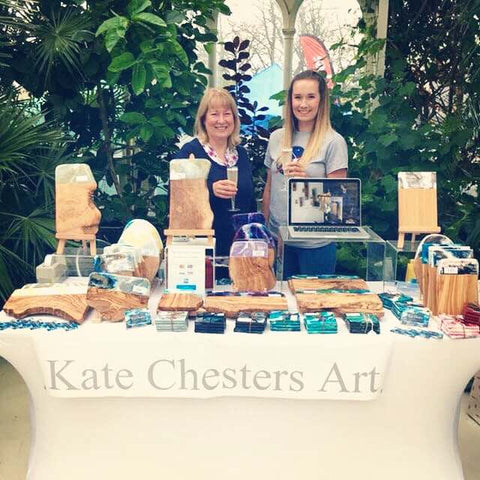
The Art of Conversation
There are certain questions that customers will repeatedly ask. For me, it’s “what material is this?” and “how do you make this?”.
Now, I could have a sign which answers these questions. But then that kills so many potential conversations. I specifically attend art markets so I can meet customers and engage with them about my work. I may be repeating myself a hundred times during that day, but each time I’m creating a new connection. And that person will hopefully remember my work more than somebody with a sign who they didn’t interact with.
Know when to talk… and when to shut up
A major thing that bugs me when I’m in a shop is when a sales assistant bombards me with offers to help. I know, I know - they’re just doing their job. I used to work in a clothes store, so I know how it is.
Personally, I like to browse in peace. And if I need help, I’ll ask for it.
But not everybody is like me. Many people visit art markets so they can meet their local artisans, and learn about their craft process.
This skill will come with time, but take clues from people’s body language. If their head is down and they’re avoiding eye-contact, they probably don’t want to talk. But if someone is having a good look through your items, be brave and say hello!
There is definitely an art to striking up a friendly conversation with a stranger, and it can be hard at first. My best advice is to smile and be happily available to talk or answer any questions.

So, art markets. Are they really worth it?
For me, the answer is absolutely yes! I’ve had some really successful days at art markets, and with continuous research and honing I find the successful days far outweigh the unsuccessful. I enjoy meeting people and hearing feedback about my work. And I always enjoy having a glass of prosecco to celebrate at the end of the day!
I hope you’ve enjoyed reading this article, and you’ve found useful information which you can use yourself at art markets. Do you have any particularly good/bad experiences? What is your best tip for exhibiting work at events? Let me know in the comments and we can discuss!

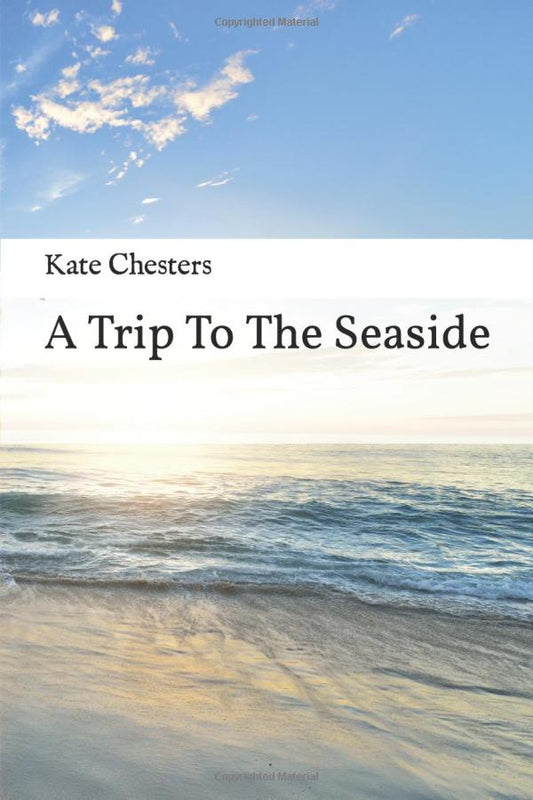

5 comments
Hurry up and join the busiest slot site in Indonesia right now, the games are easy to understand and there are also lots of other interesting bonuses, to register you can directly click on the link.. SUKALIGA
Thank you, this is super helpful. I have been making so much art over the last year or so, I would like to have a go at selling it. I did some markets nine years ago before my eldest was born, but I feel like it’s changed so much in that time, so I feel like I’m floundering when it comes to knowing where to start. Your article has given me a bit more confidence – thank you.